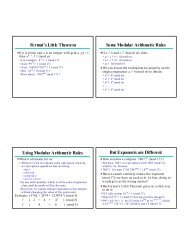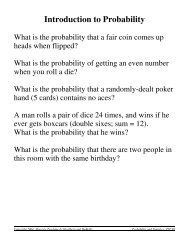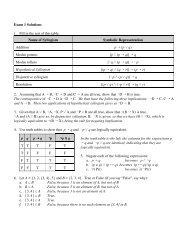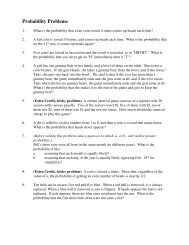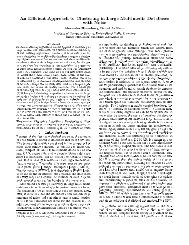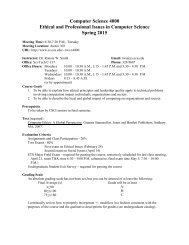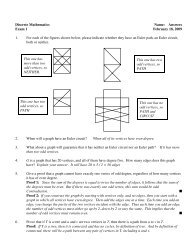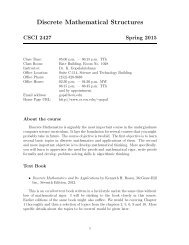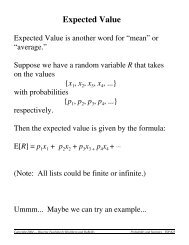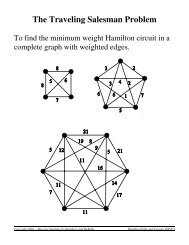Worksheet 1
Worksheet 1
Worksheet 1
Create successful ePaper yourself
Turn your PDF publications into a flip-book with our unique Google optimized e-Paper software.
Practice Problems:<br />
1. Complete the tree diagram. Use it to make a systematic listing of all possible arrangements of the<br />
four letters A, B, C, and D. Confirm the number of arrangements using the multiplication rule for<br />
counting.<br />
2. Six different colored blocks are lined up in a row. How many color arrangements are possible?<br />
3. A teacher who loves discrete math gives a workshop which causes 17 other teachers to love<br />
discrete math. Then each of those teachers teaches discrete math to 22 students, who gain such an<br />
appreciation of discrete math that they each go home and tell both of their parents an interesting<br />
discrete math fact. How many parents has the original teacher thereby influenced with her single<br />
workshop?<br />
4. How many different colorings are possible if each small square in each of<br />
these arrangements is either shaded or left blank? Support your answers<br />
by listing systematically all of the possibilities.<br />
5. When Alice sends Bob a card, she always adds a string of 5 X’s and/or O’s after her signature,<br />
with one restriction: she never puts two O’s next to each other, because Bob turns them into smiley<br />
faces, and she can’t stand that. Thus, for example, “OXOXO” and “XOXXO” would be allowed,<br />
but “XOOXX” and “OOXOO” would not. Systematically list all the different ways for Alice to<br />
add X’s and O’s to the card. How many ways are there?<br />
6. Start with the letters in the word graphs.<br />
a. How many ways can you select and arrange 2 of the letters? 1 letter? 1 or 2 letters? 3, 4,<br />
or 5 letters?<br />
b. Explain the counting techniques used in terms of the multiplication and addition rules.<br />
7. The Perfect Spy, Agent 006, is sealed inside a room with no way to escape. With him in the room<br />
is a time-bomb set to explode in 9 minutes. It would take him just 30 seconds to defuse the bomb,<br />
except that it is locked inside a suitcase that has a combination lock on one of the clasps. To open<br />
the lock, he has to set three dials, each containing the digits 0-9, to the correct positions. He is able<br />
to check two of these combinations per second, thanks to his top-notch manual dexterity. Is he<br />
guaranteed to be able to open the suitcase with enough time left to defuse the bomb?<br />
8. Make a tree diagram showing all arrangements of the letters in the word “REED”. How many are<br />
there?
9. The figure to the right shows 4 rooks placed on a 4x4 “chessboard” in such a<br />
way that no rook attacks any other rook. (In chess, a rook attacks pieces<br />
which lie in the same row or column as itself.)<br />
a. List systematically all the ways to place 4 non-attacking rooks on a 4x4<br />
board. Use the grids on page EX 4. (In the diagram, the rooks are at<br />
squares A-4, B-1, C-3, and D-2.)<br />
b. How many ways are there?<br />
c. Is there a way to use the multiplication rule to find this answer?<br />
A B C D<br />
1<br />
2<br />
3<br />
4<br />
10. a. How many 3-digit numbers are there where each digit is odd?<br />
b. How many 3-digit numbers are there where each digit is odd and all three digits are different?<br />
c. How many 3-digit numbers are there where each digit is odd and the three digits appear in<br />
increasing order? (For example, 157 is such a number.) Can you answer this question using<br />
the multiplication rule?<br />
11. In this problem, we use the word “word” to mean any sequence involving the indicated letters. For<br />
example, SUSUSU is a six letter word using only S and U, as are SSSSSS and UUUSSS.<br />
a. How many six letter words can you make using only S and U?<br />
b. How many four letter words can you make using only R, E, D?<br />
c. How many five letter words can you make using R, E, A, D?<br />
d. If you wanted to make that many words (the answer to part c.) using only S and/or U, how<br />
long would you have to make the words?<br />
12. Make a tree diagram showing all arrangements of the letters in the word “REED”. How many are<br />
there?<br />
13. How many arrangements are there of the letters in the word “SEVEN”? In how many of these are<br />
the E’s together? In how many are the E’s separated?<br />
14. Two players compete repeatedly until one wins two successive games or three games total. How<br />
many different sequences are possible? What if you change “three games total” to “four”?<br />
15. A set of five regular octahedral dice have eight faces numbered 1, 2, 3, 4, 6, 8, 12, and 20. In how<br />
many different ways can these five dice fall? In how many ways will the five dice show a sum of<br />
six? of seven? What are the chances of rolling a sum of six or seven?<br />
16. Not long ago, there were five teams in the East and Central and four in the West Division of both<br />
the American and National Baseball Leagues. How many different standings were possible for the<br />
28 teams when ranked within their divisions? within their leagues? all together? Assume that there<br />
are no ties. How many World Series team match-ups were possible?<br />
17. As I was going to St. Ives, I met a man with 7 wives. Each wife had 7 sacks, each sack had 7<br />
cats, each cat had 7 kittens. Kittens, cats, sacks, wives ... how many were going to St. Ives?
A Tree Diagram for Arranging 4 Letters<br />
How would you place the letters A, B, C, and D into these boxes to show all the ways<br />
to arrange these four letters? How many ways are there altogether to arrange these<br />
four letters? Can you see how to get that number using the multiplication rule?



